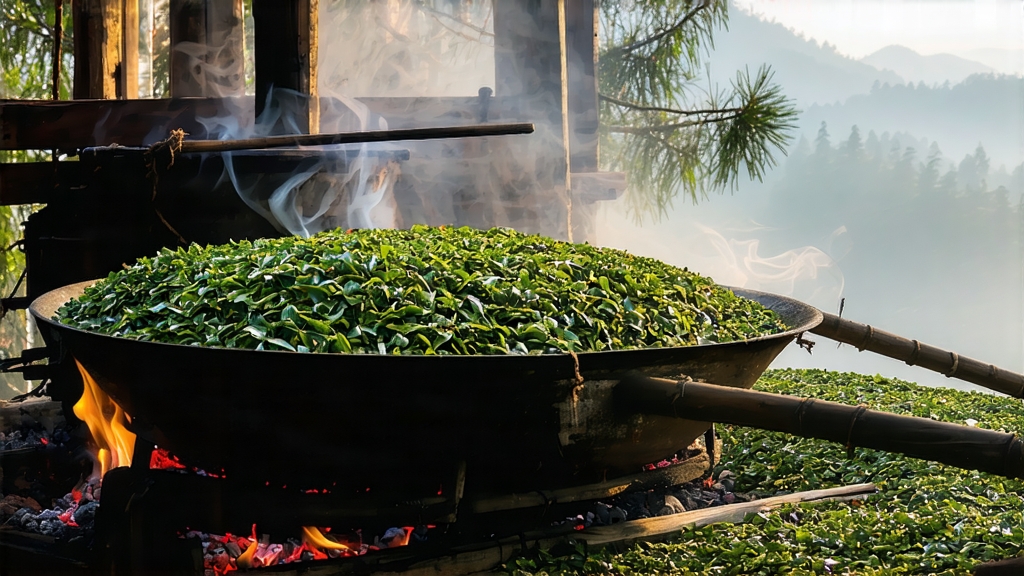
Long before English porcelain teacups clinked in London drawing rooms, before the East India Company weighed anchor for Canton, the rugged cliffs of the Wuyi Shan in northern Fujian echoed with the sound of axes splitting pine. It was here, in the mid-seventeenth century, that the world’s first fully oxidised leaf—what the Chinese call hong cha, “red tea,” and the West knows as black tea—took shape under an accidental veil of smoke. The tea was Lapsang Souchong, and its birth story is as layered as its flavour: a tale of war, trade, and the alchemy of wood, air, and time.
Legend places the origin during the late Qing turmoil. Tea growers, fleeing bandits or imperial levies, hurriedly dried freshly rolled leaves over open pine fires to prevent spoilage. The impromptu process imparted an unmistakable resinous aroma that travelled surprisingly well along the rocky horse paths to the port of Xiamen. Dutch merchants carried the novel “bohea” (a corruption of “Wuyi”) to Europe, where it seduced the English court and laid the groundwork for the afternoon-tea ritual. Thus, Lapsang Souchong—literally “small sort from Lapu Mountain”—became the primogenitor of every black tea that followed, from Assam to Ceylon.
Today the name covers two distinct styles. The traditional “smoked” version, still crafted in Tongmu Guan, a protected enclave inside the Wuyi National Nature Reserve, obeys strict geographical indication rules. Only leaves plucked within the 565 km² core zone may bear the designation “Zheng Shan Xiao Zhong,” literally “Original Mountain Small Variety.” A newer, “unsmoked” style, often labelled simply as Xiao Zhong, caters to modern palates that favour the tea’s natural fruit-and-honey sweetness without the campfire note. Both, however, spring from the same Xiaoyezhong tea trees—small-leaf Camellia sinensis var. sinensis bushes that have clung to volcanic tuff for centuries, their roots tickled by mineral-rich mists rising from the Jiuqu Xi, the “Nine-Bend Stream.”
Crafting smoked Lapsang Souchong is a choreography of heat, timing, and intuition carried out in three-storey wooden houses whose upper floors are latticed with bamboo screens. The pluck, called “two and a half leaves,” is taken in late May, after the pre-Qingming rush for green tea has subsided. Withering begins on slatted racks suspended over dying embers of local Masson pine and cedar; the gentle warmth dehydrates the leaf while infusing it with volatile terpenes. Once the leaves grow supple—judged by the master’s practiced squeeze—they are rolled under cloth on rattan mats, coaxing cell sap to the surface for oxidation. The rolled leaf is then packed into oaken tubs lined with wet cloth, where it ferments for three to five hours until it exudes a sweet grape-like perfume. The critical smoking follows: the leaf is spread one centimetre deep on bamboo trays stacked inside a drying room directly above a pine-resin fire. For eight to ten hours the tea maker controls draught and temperature by adjusting ceiling flaps, ensuring the smoke kisses but never scorches the leaf. Finally, a charcoal finishing bake locks in moisture at 3–4 % and polishes the flavour, yielding long, jet-black twists that glisten with amber oils.
The unsmoked version diverges after rolling. Instead of pine smoke, the leaf is hot-air dried in electric ovens calibrated to mimic the gentle breeze that once drifted through Wuyi gorges. The result is a mahogany strip whose liquor is a clear russet, tasting of longan, dried apricot, and a whisper of sandalwood—an elegant counterpoint to its smoky sibling’s tar-and-treble profile.
To brew either style gongfu-style, begin with soft, neutral water brought to 95 °C. For smoked Lapsang, a porcelain gaiwan accentuates clarity; for unsmoked, a thin-walled zisha teapot flatters body. Use five grams—about two heaping teaspoons—for a 120 ml vessel. Rinse the leaf for three seconds to awaken it, discard, then infuse the first steep for eight seconds, adding two seconds with each subsequent pour. The smoked version delivers a tri-phase arc: initial top notes of pine and wintergreen,